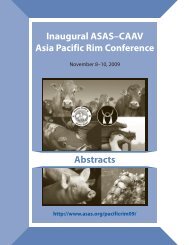2006 Abstracts - American Society of Animal Science
2006 Abstracts - American Society of Animal Science
2006 Abstracts - American Society of Animal Science
Create successful ePaper yourself
Turn your PDF publications into a flip-book with our unique Google optimized e-Paper software.
centives Program (EQIP) cost-share. For animal producers who areconsidering applying for Conservation Securities Program (CSP) payments,implementing a CNMP and keeping the appropriate records willprovide a solid starting point for the records needed for a successfulCSP application. <strong>Animal</strong> producers can use CNMPs to meet NPDESpermit nutrient management plan requirements and can position themselvesfor USDA incentive programs at the same time.Key Words: Livestock, Comprehensive Nutrient Management Plan,National Pollutant Discharge Elimination System121 S<strong>of</strong>tware tools for nutrient management planning: Whereare we now and where are we headed? B. Joern*, P. Hess, and B.Eisenhauer, Purdue University, West Lafayette, IN.Writing and implementing nutrient management plans (NMPs), whetherregulatory or voluntary in nature, is a complicated, calculation intensiveprocess. Planners are required to learn and use several s<strong>of</strong>tware tools(GIS mapping s<strong>of</strong>tware, nutrient management s<strong>of</strong>tware, phosphorusrisk assessment spreadsheets, RUSLE2, etc.) that were developed independentlywith little or no training, and interact with NRCS and stateregulatory agencies without a roadmap. Obtaining useful output fromnutrient management planning s<strong>of</strong>tware tools can be a challenge in manystates because they have not yet decided on an <strong>of</strong>ficial format for NMPs.This requires plan developers to spend an inordinate amount <strong>of</strong> timecreating and formatting NMPs that they hope will receive favorablereviews. In the few states that have decided on a NMP format, theusefulness <strong>of</strong> the NMP to the real end-user (the producer) is limitedbecause most NMP templates currently in use were designed principallyto meet government agency reporting requirements. Plan reviewerscurrently have little recourse in evaluating NMPs other than tomanually recalculate planned nutrient applications, risk assessment procedureresults, and other data contained in the NMP. This manual verificationprocess is slow, tedious, subject to human error and furtherincreases the cost <strong>of</strong> implementing NMPs. During this presentation, wewill discuss the current state <strong>of</strong> the nutrient management planning processand provide a vision for a more legible roadmap for this process inthe future.Key Words: Nutrient management planning, Phosphorus indexes122 Integrating animal feeding strategies into CNMP processes:Role <strong>of</strong> an updated ASAE standard D384.2. R. K. Koelsch* 1 ,W. Powers 2 , and A. L. Sutton 3 , 1 University <strong>of</strong> Nebraska, Lincoln, 2 IowaState University, Ames, 3 Purdue University, West Lafayette, IN.Feed program decisions impacts manure characteristics and several manureplanning processes. The USDA recognizes feed management asone <strong>of</strong> six key components <strong>of</strong> a comprehensive nutrient plan.To better integrate feed management into nutrient planning, a joint animalscience and agricultural engineering team produced a new ASAEstandard for improving the accuracy <strong>of</strong> estimating manure excretion.This biologically based approach includes 1) a new excreted manurecharacteristics summary, 2) equations for estimating, at a minimum, drymatter, N and P characteristics, and 3) as-removed manure characteristics.Species-specific work groups used two different approaches fortheir proposed equations. The beef, swine, and poultry groups used ananimal mass balance approach where excretion is a difference betweenintake and retention in body mass or animal products. The dairy andhorse groups published equations based upon multi-variable regressionanalysis <strong>of</strong> existing data sets. A review <strong>of</strong> these equations and theirestimates <strong>of</strong> excretion for changes in dietary or performance inputsrevealed: 1. Both dietary and animal performance variations cause significantvariation in excretion <strong>of</strong> N, P, and total solids. The equations arecapable <strong>of</strong> responding appropriately under most circumstances. 2. Regressionbased equations used by the dairy group responded with lesschange in N and P excretion for similar dietary input changes whencompared with other mass balance approaches. For changes in animalperformance, the dairy regression equations responded with an opposingtrend in excretion when compared to that produced by a mass balanceapproach. An evaluation <strong>of</strong> the performance <strong>of</strong> these equationbased estimates reveals some challenges for making situation-specificexcretion estimates. ASAE should continue its interaction with the animalscience community to encourage additional review and evaluation <strong>of</strong>these biologically based equations to further validate or improve theiraccuracy. In addition, an equation based approach for other characteristicssuch as ammonia-N and other micro-nutrients would add value tothe standard.123 Non-ruminant diet composition effects on land acreagemanure application. A. Sutton*, B. Richert, and T. Applegate, PurdueUniversity, West Lafayette, IN.Regulations have forced pork and poultry producers to determine theamount <strong>of</strong> land required for manure utilization at agronomic fertilizationrates based on N or P. Several diet manipulation strategies can reduce theexcretion <strong>of</strong> nutrients, particularly N and P, thereby reducing the environmentalimpact <strong>of</strong> swine and poultry manure. Formulating pig andpoultry diets on an available P and amino acid (AA) basis can reduce Pand N excretion (8-10%). Reducing dietary crude protein and supplementingsynthetic AA at specific ratios has reduced N excretion andammonia emissions (20-50%). Phytase addition to low P diets and use<strong>of</strong> 25-OH-cholecalciferol in poultry diets has reduced P excretion by20-30%. Feeding degermed-debranned corn has resulted in P reduction<strong>of</strong> 19-34%. Additionally, grain varieties (low phytic acid corn and soybean,Nutridense corn, high oil corn) have reduced nutrient excretionsubstantially. In contrast, by-product feeds such as distillers dried grainsand solubles, can increase nutrient excretions, especially P. Reductionsin manure P concentrations will bring the N:P ratio closer to meetingagronomic N and P needs <strong>of</strong> crops and a smaller land base for manureapplication resulting in 33 to 40% less land need for the manure application.In addition, a higher manure application rate onto cropland willmake it feasible to more accurately apply the correct amount <strong>of</strong> manureto land at a reduction in energy and labor costs. The reduced land basefor manure application due diet manipulation can result in an opportunityto expand the operation if there is currently extra land available oruse the current land base within government regulations without purchasingadditional land or moving manure <strong>of</strong>f-site. Future opportunitiesfor diet manipulation may include genetically modified/selected feeds,feed processing methods, proper by-product utilization, or additives toproduce manure with a specific composition to achieve an on-farmnutrient balance. Economic evaluation and incentives are needed to implementdiet manipulation by the industry.Key Words: Nutrient excretion, Phytase, Feed processing40
















